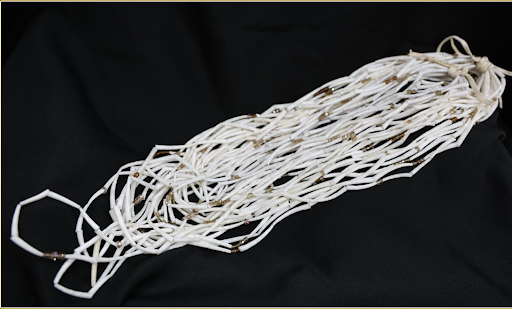Overview
Northwestern California Tribal Necklaces and Patterns for Primary Students

Authors:
Maikken Bass, Elementary Literacy Coach and Educator, Eureka City Schools
Maggie Peters (Yurok/Karuk) NASMC Learning Specialists, Humboldt County Office of Education
Joanna Galicha, Graphics Specialist Community Outreach & Engagement Team Video Editor
Grades: TK-1
Suggested Amount of Time: 60 minutes (can break into three 20 minute sessions
Curriculum Themes:
- History
- Cultural Strengths
- Relationship to Place
- Cross Curricular Integration
Learning Goals
Expose students to Yurok Language
Identify traditional materials used in Northwest Native California Indian necklaces
Recognize AB, ABC and AABB patterns
Make a pattern
Lesson Overview
In this engaging and culturally enriching lesson, young students are introduced to the Indigenous tribes of Northwestern California—the Yurok, Karuk, Hupa, Wiyot, and Tolowa. Through a short video featuring Maggie Peters (Yurok/Karuk), students gain insight into the cultural significance of necklace-making in these tribal communities. Maggie shares the importance of ceremonial regalia and introduces the traditional materials used in regalia and necklace-making by these tribes.
After watching the video, students explore patterns made with these traditional materials. They will observe how different natural items can be arranged to make patterns. Following this, children will express their creativity by coloring their own necklace pattern on a printed template.
As an optional extension, if materials are available, students will have the opportunity to create their own patterns in a bead bracelet using easily accessible materials. This hands-on activity reinforces pattern recognition, fine motor skills, and cultural appreciation.
This lesson promotes cultural awareness, artistic expression, and early math skills through patterning—all within an age-appropriate and respectful context.
Teacher Background
This lesson introduces young students in kindergarten through 2nd grade to the traditional necklace designs of the Yurok, Karuk, Hupa, Tolowa, and Wiyot peoples—Indigenous tribes of Northwestern California. While the lesson connects directly to early mathematics through pattern recognition and creation, it also serves as a powerful introduction to the cultural richness and diversity of Native American communities. It's important for educators to understand that the necklaces explored in this lesson are not simply decorative items; they carry deep spiritual and cultural significance. Often worn during important ceremonies including coming-of-age celebrations, healing, world renewal and to fix the world - restore balance, necklaces are part of traditional regalia that reflects the identity of these communities.
The materials traditionally used to make these necklaces—including dentalium shells, abalone shells, pine nuts, clam shells, olive shells, to name a few—were all harvested from surrounding environments or traded between tribes. This practice highlights the deep ecological knowledge and strong connection these tribes maintain with their ancestral lands and one another. As students learn about these materials and the patterns created with them, educators can help them understand the importance of cultural traditions, resourcefulness, and sustainability in Indigenous lifeways.
This lesson also supports culturally sustaining pedagogy, which means teaching in a way that values and preserves the cultural identities of the communities being studied. Educators are encouraged to approach this topic with care and accuracy, avoiding oversimplification or the presentation of cultural objects as generic art projects. Using authentic resources—such as the featured video with Maggie Peters, a Native artist and educator—helps ensure that the stories and teachings are shared from a Native perspective.
A key teaching point in this lesson is the distinction between cultural appreciation and cultural appropriation. Cultural appreciation involves respectfully learning about and honoring another culture, especially with permission and understanding. In contrast, cultural appropriation happens when members of a dominant culture adopt aspects of a minority culture without understanding their meaning or acknowledging their significance—often using these elements out of context or for personal gain. When it comes to traditional necklaces, it’s important for students and educators to recognize that while it's valuable to observe and be inspired by the materials and patterns, it would be inappropriate to recreate, replicate, or sell these sacred items, especially without tribal guidance or permission.
When introducing young learners to these topics, educators can encourage respectful curiosity by explaining that these necklaces are special and meaningful, often made with great care and passed down through families. Children can be taught that learning about another culture is a privilege, and that respect is shown through listening, appreciating, and refraining from imitation. By framing the lesson with care, educators not only deepen students’ mathematical understanding but also help them develop empathy, cultural humility, and an appreciation for the richness of Indigenous traditions.

